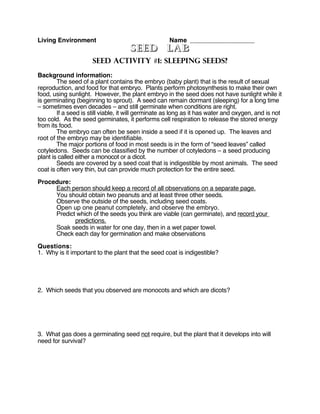
Seed Germination Lab Guide
- 1. Living Environment Name __________________ Seed LabSeed Lab Seed Activity #1: Sleeping Seeds? Background information: The seed of a plant contains the embryo (baby plant) that is the result of sexual reproduction, and food for that embryo. Plants perform photosynthesis to make their own food, using sunlight. However, the plant embryo in the seed does not have sunlight while it is germinating (beginning to sprout). A seed can remain dormant (sleeping) for a long time – sometimes even decades – and still germinate when conditions are right. If a seed is still viable, it will germinate as long as it has water and oxygen, and is not too cold. As the seed germinates, it performs cell respiration to release the stored energy from its food. The embryo can often be seen inside a seed if it is opened up. The leaves and root of the embryo may be identifiable. The major portions of food in most seeds is in the form of “seed leaves” called cotyledons. Seeds can be classified by the number of cotyledons – a seed producing plant is called either a monocot or a dicot. Seeds are covered by a seed coat that is indigestible by most animals. The seed coat is often very thin, but can provide much protection for the entire seed. Procedure: Each person should keep a record of all observations on a separate page. You should obtain two peanuts and at least three other seeds. Observe the outside of the seeds, including seed coats. Open up one peanut completely, and observe the embryo. Predict which of the seeds you think are viable (can germinate), and record your predictions. Soak seeds in water for one day, then in a wet paper towel. Check each day for germination and make observations Questions: 1. Why is it important to the plant that the seed coat is indigestible? 2. Which seeds that you observed are monocots and which are dicots? 3. What gas does a germinating seed not require, but the plant that it develops into will need for survival?
- 2. Seed Activity #2: Design-a-Seed Background information: Many seeds are designed for maximum dispersal – ensuring that the seeds end up as far from the parent plant as possible. There are different methods by which this is done: seeds in fruits that animals will disperse, seed coat with hooks that snag on animals, and seeds that are carried by wind. It is this last group that you will be investigating. Many seeds are designed to catch wind currents or fall very slowly so that the wind will carry them away from the parent plant. Procedure: You will use a paper clip to represent the main body of the seed. Design a “seed coat” that will enable the “seed” to be carried by wind. You may use (but are not limited to) the provided materials for the seed coat. Your paper clip must stay attached to the seed coat. As you build your seed, you may test it so that adjustments may be made. Assessment: Your seed will be dropped in front of a fan blowing on medium speed to see how far it travels. It will be dropped twice, with the longest distance counting. Bonus points will be added to the grades of those whose seeds travel the farthest. Questions: 1. Describe and sketch the seed coat that you designed. 2. Describe in detail how your seed coat enables wind to carry the seed. 3. Research wind-borne seeds. Name three plants whose seeds are carried by the wind, and describe how each seed catches the wind.
